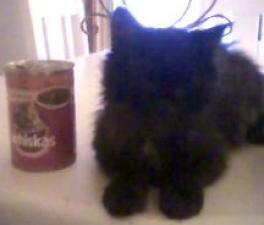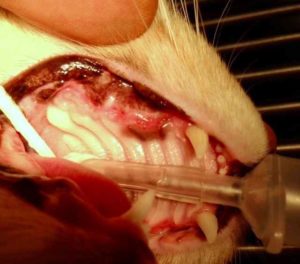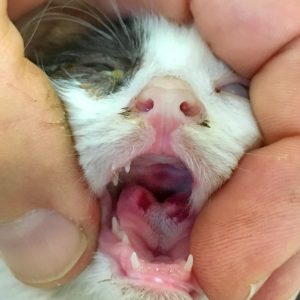Updated September 3, 2021
Many of our cat-owning clients will already know how much we hate the name ‘cat flu’. The name comes from a time when we didn’t fully understand what these viruses were. These are serious diseases with often lifelong consequences for the infected cat. Here are the stories of four such cats: Felix, Sooty, Princess and Twitch.
Limping Kitten Syndrome
Felix is a kitten from the Animal Welfare League, which means he has had a better than average start to life. He was sold having had a vet checkup, his desexing operation, a microchip, worming, flea control and the first F3 vaccination.
It wasn’t long before his new owners noticed something was wrong. He wasn’t playing or moving like when he first came home, and he started eating less and losing weight. His owner, who was a doctor commented that he looked like he had reactive arthritis.
He was quite right. When we examined Felix, he had a fever, signs of malnutrition from a poor appetite, and multiple swollen and painful joints. He could barely walk and only did so in a grossly stilted gait as if every joint in his body were painful, which they probably were. He also had that classic sign of a sick cat; the staring coat, which is what we call a clumped, dull and ungroomed coat.
This pattern of signs and symptoms is characteristic of Limping Kitten Syndrome, which is arthritis caused by Feline Calicivirus, one of the ‘cat flu’ viruses.
The video shows him well on the road to recovery, looking well and almost walking normally. He will stay on anti-inflammatory treatment until he no longer has joint pain, and apart from being a calicivirus carrier (see below), should live a normal life.
Neurological Problems
Sooty and Princess are the sole survivors of a very unlucky start to life. They were born to a mother infected with feline herpesvirus, the other cat flu virus. Although the mother did not appear to be sick, she passed the infection on to all her kittens. When this happens, the virus as it spreads causes a range of disease depending on the age of the foetus or kitten.
The older foetuses can probably survive the infection but are often born with significant damage, whereas the younger foetuses die and are either aborted or stillborn.

Sooty was born with or developed herpesviral neurological disease (we don’t know which as the kittens weren’t seen for the first few weeks). This led to damage to the developing nervous system, giving him the appearance of a human with cerebral palsy. However, he is also generally in poor health and struggles to maintain a healthy weight. At two years of age, even with good care his long-term outlook is guarded at best and his mobility is very poor. Note his size compared with Princess below.
Update 2018: Sooty died suddenly around a year after this blog was written.
Herpesvirus Ulcerative Dermatitis
Twitch was a kitten from a litter just like Sooty and Princess’s. In fact, he’s called Twitch because of the brain damage he suffered. However, apart from being unsteady and uncoordinated, he’s a healthy, happy cat.
Then, all of a sudden he developed a severe facial dermatitis. Painful infected ulceration and crusting appeared on his eyelids, lips and especially the ears. Biopsies showed it to be caused by the same herpesvirus infection that had affected him as a foetus.
He responded extremely well to anti-inflammatory and antibiotic treatment, but we expect he will suffer relapses from time to time.
Gingivitis & Stomatitis
Princess was luckier. She was probably infected later than Sooty. Therefore she was able to fight the infection better and is generally healthy.

Her problem has been one that happens to many cats who recover from cat flu. They become carriers of the virus, and for reasons we don’t fully understand, it causes severe and persistent oral inflammation and ulceration. These cats suffer from painful gingivitis and stomatitis (mouth inflammation), progressing to periodontitis. In Princess’ case, she was in severe pain from infection and loose teeth.
In these situations, it is often necessary to remove all the teeth behind the canines. As shocking as this may seem, it usually results in a cure to the mouth problems and pain. Other treatments for stomatitis can be found here.
We are always asked, “How will they eat with no teeth?” The simple answer is that their mouth is so painful from the infection that they always eat a lot better afterwards. Most cat food really doesn’t require teeth anyway!
We are happy to report that since Princess’ teeth have been removed, the gums have healed and she no longer has mouth ulcers or pain. That’s her mouth above. Click here for other causes of mouth ulcers.
What Is Cat Flu Anyway?
These manifestation of calicivirus and herpesvirus infection are unusual. Follow this link to read about the common symptoms of cat flu.
It’s important to remember that in protecting your cat, these viruses are highly contagious. Many stray cats are shedding the virus, and any shared objects such as rubbing posts or water bowls as well as hands and clothing can spread the disease. Vaccination is the safest form of prevention, and over time it has dramatically reduced the number of sick cats we see with these diseases. Read how we prevent these diseases at Cat Vaccination Explained.
Have something to add? Comments (if open) will appear within 24 hours.
By Andrew Spanner BVSc(Hons) MVetStud, a vet in Adelaide, Australia. Meet his team here. The information provided here is not intended to be used as a substitute for going to the vet. If your pet is unwell, please seek veterinary attention.


Hi,
I adopted a kitten 9 years ago and was told that she contracted cat flu from her mother. Her growth is stunted, has deformities, lost most of her teeth and really bad weepy sore eyes. But I question if she has just been unlucky at birth being the runt of the litter and general age related issues instead because she has grown up around other unvaccinated cats for a time and has never once passed any flu/symptoms to the others. I’m confused and also concerned as my partner now wants a kitten to keep the old gal company.
Hi Nicola. I think her history sounds entirely plausible, and so I would be very careful about new introductions. My advice is to at least make sure that they are fully vaccinated before they are introduced.
i bought a kitten back in 2012 from a breeder she had bathed him and covered him in talcum powder which i thought odd
i took him home and he immeidietly became very sick
i took him to the vet who said he had upper respiratoy infection this was the start of a lifeling thing to save him he had 6months of antibiotics the infection cleared up but he was left with a noise and congestion like a permenant cold vet thinks its either calicvirus or herpes few years later he developed severe stomatits and had all his teeth out i didnt know at the time but 3 other of my cats developed stomatis and 1 was put to sleep and she was so ill and developed a virus my vet says calicivirus and all my cats will be infected over the last 6 years 4 cats have been put to sleep the kitten i bought is now almost 10 and he has been sick all his life i towel feed him 3 times a day he eats the odd bit on his own but not much he has mouth ulcers and a wheeze ive tried everything even putting him in a steamer, his cold and runny nose never goes my vet wants him put to sleep
i have 2 more with stomatits and touch wood doing ok
so have i unwittingly spread this awful virus to all my cats
what can i do? they are on loxicom
bruce the cat i bought sick i didnt know is small and thin
Hi Jayne. While it is true that calicivirus is associated with gingivostomatitis, virtually all cats that are exposed to the virus do not develop the disease. There are other factors which are poorly understood. Therefore you should not feel responsible, and what you are have experienced is a terrible coincidence.
I am fostering a litter of kittens (4) about 8 weeks old and one single kitten who is about 2 or 3 weeks older than them. They were all spay/neutered about 3 days before the first kitten started to limp on his front paw. They all became much more sedate and stopped their rough house playing. They are sleeping much more now post-op like they did at around 3-4 weeks, plus their appetite is down. They used to eat like pigs. I also think they got their first vaccinations at the same time.
One by one they all began limping on front paw but show no signs of respiratory illness. I’ve read that the vaccination can cause the limping and it will run its course. Is this true? They are much more whiney and seem to be able to sleep comfortably albeit more than usual. Is there a need for pain meds?
Yes, that is true. Sometimes cat flu (including strains in vaccines) can cause limping. You can see the video of such a kitten in this article. Pain relief works very well and I encourage you to talk to your vet about using meloxicam. That will also allow you to be sure that it really is a caliciviral arthritis and not something else.
Hi, I just adopted two 2 month old sibling kittens from Peggy Adams. The boy started to first show symptoms of lethargy and a limp in one leg, which then turned into a fluctuating fever (104 to 106), and a lot of sleeping. I rushed him to the emergency vet (@ 1am) who said he had a virus that needed to run its course but they gave me Clavamax for the fever… This emergency vet told me it wasn’t contagious. She thought it might have come from their first vaccines he had received a few days before.When i went to a regular vet the same day they also said it was a Virus but that it was contagious. Now I am pretty sure his sister has it. She is showing lethargy, a lot of sleep, fever @ 103 and 104 degrees Fahrenheit. She keeps holding up her right leg with a limp. Could this be a strain of the Calcivirus? (I think my other two cats who are 1 and 2 year old cats [with up to date shots] have been exposed as well, should I be worried?)
Hi Hope. It’s certainly possible that the virus has come from the vaccine. It’s very uncommon though for a vaccine strain to then spread to another cat. If you have acquired the kitten within the past seven days it’s probably more likely that the virus is of wild origin and was being incubated. Of course we’ll never know for sure. Crossing fingers!
Hi Ive noticed a cold sore type on the front of my 2 year old cats mouth, there’s been a few cats hanging around my house and she escaped a couple of days ago and I found it hard to get her back in she eventually did come in but I haven’t let her get out or let her out she’s become very distant she used to sleep on my bed but now goes under my bed she’s sleeping all the time and she just doesn’t want to know anyone? I’m just wonder what it can actually be as I’m really worried about her.
Hi Sharon. She sounds sick and needs to see a vet.